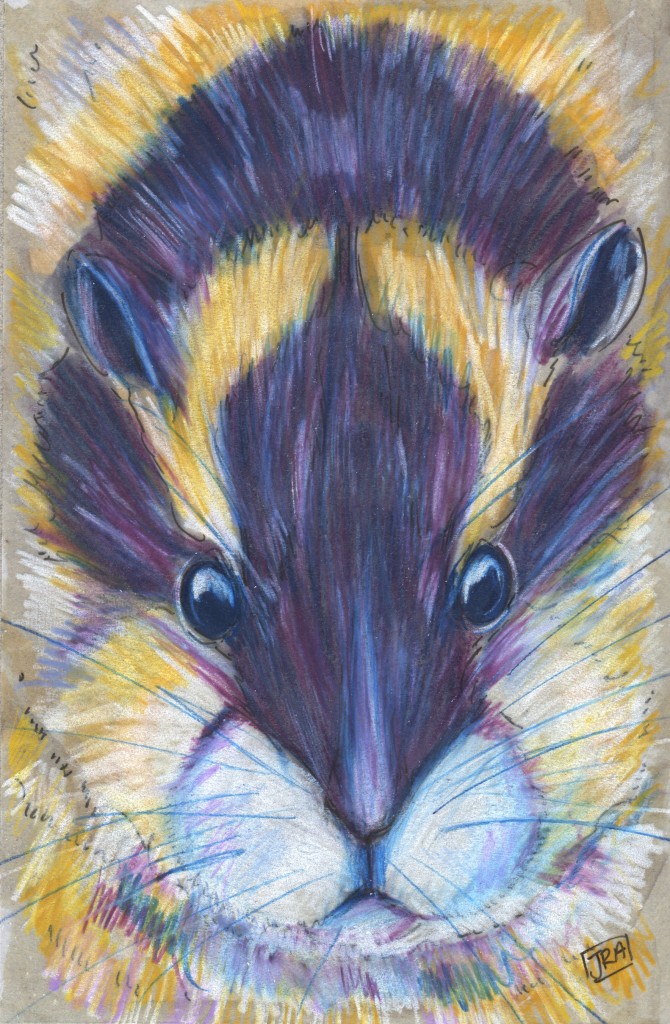Norway Lemming (Lemmus lemmus)
Poor lemmings. We should thank them for how generously, if unwittingly, they have lent us their name as a metaphor for the unthinking hordes, who would indeed jump off the Brooklyn Bridge if their best friend did, who blindly follow the rest of the group, make the same bad decisions everyone else makes, and ultimately self-destruct, allowing the rest of us to smirk self-righteously. We’re not lemmings!
But it turns out that lemmings aren’t lemmings, either, in the sense of being brainwashed members of a mass-suicide cult. They don’t rush heedlessly to the sea, and they don’t throw themselves off of cliffs to their drowning deaths. Not exactly. What happens is that the lemming population fluctuates like crazy. A female Norway lemming can begin reproducing when she’s only two weeks old, and after that, she can have a new litter every three weeks. (The average litter size is 5 lemminglets.) So by the time she’s having her second litter, she has already become a grandmother, and by the time of her third litter, she could be a great-great, for pete’s sake.
Faced with harsh Scandinavian conditions and scarce food, lemmings might slow down the childbearing during the lean months. Then, as Ivan T. Sanderson puts it in Living Mammals of the World, “things get out of hand,” and the lemmings make up for lost time by having as many children and grandchildren and great-great-great-great-great-great-grandchildren as they can stand. These legions of lemmings devour all the available roots, grass, bark, leaves, and berries, and then what? They’re out of food, and there are thousands of them, and they can’t just stay there or they’ll all starve.
So they leave. And because they’re social, they leave en masse, but not necessarily solely in one direction. They may kind of fan out, searching for a new place to call home. They’re pretty good swimmers, and they have no problem crossing the occasional fjord or river. In Norway, any dissatisfied lemmings who haven’t found a suitable place to set up shop will, inevitably, come to the sea. And some of them—perhaps thinking it’s just another fjord, perhaps just wanting to keep going—will end up in it, only to drown. So, yes, lemmings have been known to plunge into the ocean and to die there. But it’s not a regular thing, it’s not every lemming, and it’s not in a precision-formation army of rodents on a mindless march to their doom.
The prevailing explanation for why the myth has stuck so well involves a sad story of duplicitous documentarians. In 1958, Disney won the best documentary Academy Award for its movie White Wilderness, which was about the wildlife of Canada. Check out this sequence:
Dramatic, isn’t it? Heartbreaking? Horrifying? Yes. But fake! Fake fake fake! The filmmakers made this segment in a part of Canada where there are no lemmings. They imported the little fellows and made them run around on a turntable they covered with snow. Then they chased them to a cliff and pushed them off of it! All to make you think that lemmings commit mass suicide. Infuriating! (Here’s an article with some more details.)
Animal Planet ran a segment in its Most Extreme series about the lemming-suicide misconception:
So that’s that. Some “documentary.” A blight on the Academy, if you ask me. Anyway, Norway lemmings are about five inches long, cute as heck, shaped somewhat like tribbles, and active year-round, both day and night. So they have difficulty controlling themselves sometimes. Who doesn’t?


Wow. Fascinating!
Growing up on such documentaries, I often wondered how they were made. I mean, obviously back then they didn’t have microscopic fiber-optic cameras to inset into anthills or prairie dog tunnels — so something was staged. And I guess, if you believe something that’s wrong, you’re going to stage the wrong event, and people will think you’ve recorded something that was actually happening the way you say it was.
It’s just to hard to watch those poor lemmings falling to their deaths off those cliffs, especially now that I know they were pushed! Of course, I also felt bad about the tribbles when they died…
Oh, almost forgot to add: beautiful drawing! Very bold composition, and great line work!
Very nice drawing! Be careful, you might become skeptical!
Ted, I’m sure there must be an accepted ethical code for documentarians about what you can and can’t recreate. In one example I read, someone mentioned David Attenborough’s The Life of Birds. Apparently, there’s one really cool shot of a duck flying, and the camera is pointed from one wing tip to the other. Well, they used a trained duck that flew alongside a car, and filmed it from the car. First of all, you can train ducks? And second, I think it’s totally different since, presumably, the point of that was to show an up-close look at a bird in flight. Now, if Attenborough had said, “Ducks are known to fly alongside cars, and some drivers help the ducks migrate by driving south for days,” or something like that, and then used the footage of the trained duck as illustration, that would be analogous to the lemmings.
Also, I don’t think I mentioned that the only lemmings that have ever been known to plunge into the sea are the Norway lemmings in Norway, not the lemmings in Canada, where White Wilderness was filmed, which are a different species. Plus, Canada is much bigger than Norway and there’s no real reason to keep going to the sea.
Chilejack/Dad, skeptical is good. It’s cynical that’s a problem!
Very interesting information and a great drawing. A lemming (as we usually think of them) is what a mother wants her child not to be. “If your friend jumped in the ocean would you do the same thing?”
Exactly! Or as you used to say, “Well, I’m not everybody else’s mother!”
poor lemmings, getting abused by disney like that. doesn’t surprise me though.